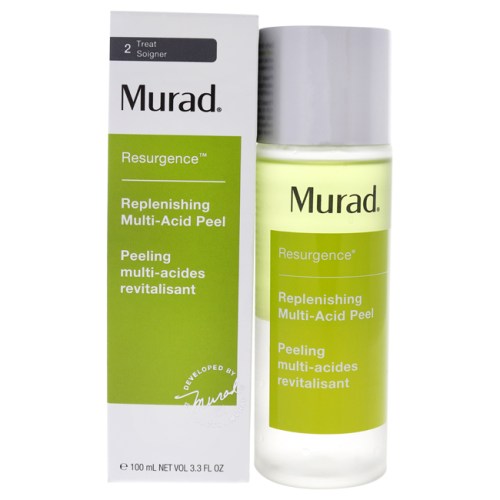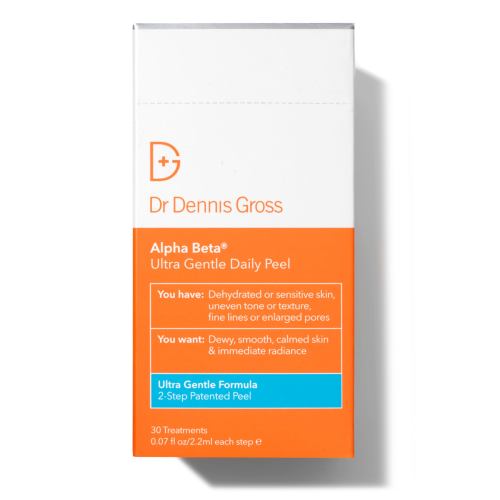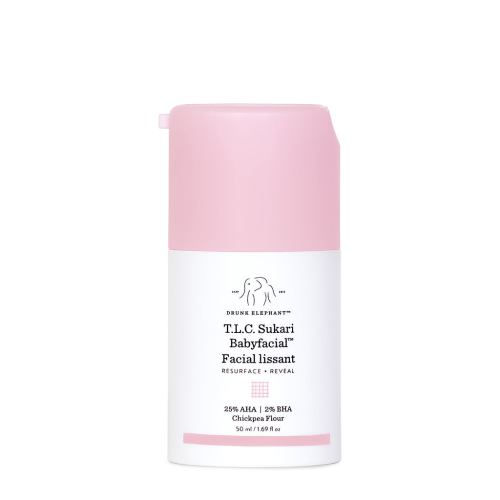Our editors independently select these products. Making a purchase through our links may earn Well+Good a commission
Chemical Peels for Sensitive Skin Don’t Have To Be Scary—Here Are 7 Derms Always Recommend
Derms reveal the best chemical peels for sensitive skin, and share the most important practices for avoiding irritation.

As someone with extra-sensitive skin, the sheer thought of a chemical peel evokes a nightmarish image of a red, painful complexion—which isn’t any fun at all. But if done correctly, this type of treatment isn’t something you have to be afraid of: as long as you’ve got the right regimen in place, chemical peels for sensitive skin can leave you looking radiant instead of raw.
Experts in This Article
board-certified plastic surgeon and founder of Dr. Devgan Scientific Beauty
board-certified dermatologist and founder of Skinfluence
board-certified dermatologist
At their simplest, “chemical peels resurface the color, texture, and appearance of the skin for an improvement in hyperpigmentation, fine lines, and overall glow,” says Lara Devgan, MD, a board-certified plastic surgeon based in Los Angeles. They’re designed with potent exfoliating ingredients that gently remove the dead skin cells from the surface of the skin for a smoothing, brightening effect.
To ease any reservations you have about chemical peels for sensitive skin, we’ve tapped three dermatologists to break down exactly how those of us prone to irritation should approach integrating chemical peels into our routines.
Benefits of chemical peels
According to dermatologists, chemical peels are most effective in removing the more challenging skin concerns that appear as our skin matures. “Chemical peels are often used in the treatment of acne, hyperpigmentation, and signs of skin aging, such as sunspots,” says Rina Allawh, MD, a board-certified dermatologist.
Because of their extra powerful ingredients, they’re able to remove the dead or dull skin from the top layer of our face and reveal a more even skin tone. They also help to jump-start cellular renewal, bringing healthy, new skin cells to the surface of the skin to replace the dead, dull ones that you’re melting away. Especially as we age and our skin matures, it can become extra challenging to get rid of discoloration or scarring, so that’s why dermatologists turn to potent acids to treat tougher-to-solve skin concerns.
What to look for in a chemical peel for sensitive skin
If you have sensitive skin, it’s normal to feel intimidated by chemical peels. While some of the stronger options on the market can cause irritation, there are chemical peels specifically designed for sensitive skin.
Board-certified dermatologist Marina Peredo, MD, advises using chemical peels with lactic acid, which is known to be one of the gentlest alpha-hydroxy acids on the market. Like all AHAs, lactic acid helps to break the “glue” that holds dead skin cells to the surface of your skin, but because the molecules are small, they don’t penetrate the skin as deeply as harsher acids, like glycolic. “Lactic acid helps speed up cell renewal, helping lessen visible acne scars, and glycolic acid has amazing anti-aging benefits,” board-certified dermatologist Dennis Gross, MD, previously told W+G.
According to Dr. Allawh, patients with sensitive skin should avoid botanical ingredients in chemical peels. “I have found that some chemical peels may even contain various botanical ingredients and may be labeled as ‘natural,’” she says. “Certain botanical ingredients may be irritating and may contain a natural fragrance that may trigger certain skin allergic reactions.”
At-home vs. in-office chemical peels
If you’re looking to try out a chemical peel, there are two types to choose from. The first, in-office, means going into your dermatologist’s office and receiving treatment. These can be pricier but will be formulated based on your specific skin-care needs, and a derm will be able to help you choose a peel that best works for your sensitive skin.
On the other hand, there are a wide variety of at-home chemical peels that gently address hyperpigmentation, acne, and dullness. They tend to be less potent to prevent irritation (certain acid strengths can old be used at the hands of a professional) and work best if used consistently.
“The difference between at-home and in-office peels is dependent on the ingredients used and the potency (strength) of the ingredient,” says Dr. Allawh. “In-office chemical peels may contain TCA or glycolic acid, but given the higher strength of the ingredients, certain in-office peels may require neutralization afterward to prevent skin irritation.”
If you’re not sure which route to go, at-home chemical peels are a great place to start because you’ll be able to see how your skin reacts to the potent ingredients, and they’re gentler on the skin. “At-home chemical peels will be much gentler than an in-office peel,” Dr. Peredo says, “At-home chemical peels can be in the form of a disposable pad, an overnight serum, or a face mask. At-home chemical peels will only affect the most outer layer skin.”
How to treat your skin to an at-home chemical peel for sensitive skin
Before applying the chemical peel to your face, it’s crucial to prepare your skin. “Prep your face by cleansing your face with a gentle, hydrating cleanser.” Dr. Allawah says, “I recommend the CeraVe Hydrating Cleanser because it’s rich in hydrating ingredients such as ceramides.”
After you’ve applied the peel, be sure to give your skin extra hydration to prevent irritation and redness. Dr. Devgan recommends using “soothing emollient moisturizer,” such as SkinCeuticals Daily Moisture ($63) and EltaMD Moisturizer ($18), to calm the skin’s barrier and protect it from irritants and environmental factors.
Lastly, apply sunscreen. “Your face will be more sensitive to the sun afterward,” Dr. Peredo explains. It will be more susceptible to sunburn after a chemical peel, which can add to existing hyperpigmentation and create fine lines and wrinkles.
The best chemical peels for sensitive skin, according to dermatologists

The Ordinary AHA 30% + BHA 2% Exfoliating Peeling Solution — $8.00
With its powerhouse solution of glycolic, salicylic, and lactic acid, this chemical peel from The Ordinary is great for sensitive, acne-prone skin. “This product is helpful for anti-aging, unclogging pores, and uneven complexion,” says Dr. Allawh. “I recommend leaving this product on for 5-10 minutes and then gently rinsing it off with a gentle cleanser followed by a moisturizer.”

Purlisse Watermelon Energizing 2 Minute Polishing Peel — $8.00
The Watermelon Polishing Peel from Purlisse is free of parabens, minerals, and synthetic coloring, which derms say make it gentle enough for sensitive skin. “It contains glycolic acid, aloe, and Lactic acid which collectively help exfoliate, as well as Vitamins A, B, and C and other antioxidants to help improve the texture of the skin and protect the skin barrier from external stressors,” says Dr. Allawh.

Boscia Exfoliating Peel Gel — $34.00
This chemical peel has the perfect balance of antioxidants and AHAs to provide a gentle exfoliation that won’t irritate sensitive skin. It works on the skin’s outer layer to remove dead skin cells, leaving your complexion brighter.

Murad Replenishing Multi-Acid Peel — $68.00
According to Dr. Peredo, the multi-acid peel from Murad has powerful ingredients that deeply exfoliate the skin, but is gentle enough to use on easily-irritated skin. “It is formulated with lactic, glycolic, and malic acids to remove dead skin cells,” she explains, adding that these acids speed up cell turnover to keep the skin feeling plump.

Dr. Lara Devgan 10-Day Retinoid Micropeel — $300.00
According to Dr. Devgan, this peel combines all her go-to exfoliants. With ingredients like hydration-boosting hyaluronic acid, cell-turnover stimulating retinol and bakuchiol (a natural ingredient that works similarly to retinol, but with less irritation), and a brightening vitamin CBE/ferulic acid complex, it was designed “to achieve a more focused micropeel in 10 days,” she says.

Dr. Dennis Gross Skincare Alpha Beta® Ultra Gentle Daily Peel for Sensitive Skin — $88.00
With a combination of AHAs and BHAs, this beauty editor-beloved peel from Dr. Dennis Gross has just the right amount of exfoliation. Its 2-step formula allows the skin to take in all of the exfoliating ingredients and then neutralizes the effects to prevent irritation, making it our go-to for at-home chemical peels. While the original formula is generally safe to use on all skin types, the brand recently released a sensitive-skin friendly version that offers the same effects with an even gentler delivery system.

Drunk Elephant T.L.C. Sukari Babyfacial™ AHA + BHA Mask — $80.00
This peel from Drunk Elephant has a 25 percent concentration of AHAs (glycolic, tartaric, lactic, and citric acids) and a 2 percent concentration of BHAs (salicylic acid), that work together to remove dead skin cells from the outermost layer of the skin and penetrate below the skin’s surface to unclog pores. Because of its potent ingredients, this mask should only be used one time a week to prevent irritation.
Want to be the first to hear about the latest (and greatest) SHOP product drops, custom collections, discounts, and more? Sign up to have the intel delivered straight to your inbox.
Sign up for the Well+Good SHOP Newsletter
Get exclusive deals on wellness, beauty, fitness, and food products that have been hand-picked by our editors.
Got it, you've been added to our email list.










